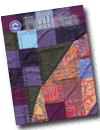|
Steadfast hope that bullets cannot destroy
By Emily Hershberger '04
I attended Sunday services in the Church of the Nativity this summer on the site where, according to Christian tradition, Jesus was born. Down in the stone caverns of the church’s belly was a gold star, marking the site of the proverbial manger and surrounded by candles and incense and an old Greek Orthodox priest in brown robes. If you were in the right mood, you could almost hum “O little town of Bethlehem, how still we see thee lie” and believe in the stillness.
But upstairs, bullet holes and graffiti marred the icons and walls. And next to that, the old Christmas carol seemed insultingly naïve.
I went to the West Bank town of Bethlehem this summer on a Service Inquiry Program (SIP) assignment to work as an “intern” with Mennonite Central Committee (MCC) and Mennonite Mission Network (MMN). I lived with Arab-Israeli and Palestinian host families while I traveled in the West Bank and Israel to visit MMN and MCC projects; spent four days with the Christian Peacemaker Team (CPT) unit in Hebron; and taught English for two weeks at a summer camp for Arab children in Nazareth.
Along the way, I spent much of my time learning and listening and generally getting a sense for the place, its people and the conflicts that have plagued them since 1948. It was in that year that Zionist Jews created the state of Israel in historic Palestine, displacing thousands of the local – mostly Muslim, but some indigenous Christian – inhabitants. With the help of the United Nations help, the Zionists relocated the Palestinians to an area less than half the size of their original lands and promised a state that has never come. The problems I saw, though ongoing, were directly related to what is called the Second Intifada – a militant, Islamic uprising against the Israeli occupation that flared up in September of 2000.
When I decided to apply for SIP, I never expected to go to Israel/Palestine. I never even expected to leave the United States. But in April, the Middle Eastern opportunity came up; the Plowshares Peace Studies Grant and generous folks at Portland Mennonite and College Mennonite churches agreed to help me with costs, and a post-SST travel bug kicked in and wouldn’t leave me alone. So I set off for one of the world’s most conflicted places without thinking much about the challenges I might encounter. After all, I was a hopeful Goshen College student with a peace, justice and conflict studies minor. I was ready – in globally aware Mennonite way – to travel in a place with guns and food shortages and conflict ripe for transformation.
So I flew off to Tel Aviv, adventurous and generally optimistic. And then I arrived.
First thing off the plane, an Israeli airport official, voice harsh and disdainful, told me to go back to the USA. “This is a war zone,” she said. “It’s dangerous here and you are crazy to come. What are you studying anyway?”
A few days later, while touring the Galilee, F-16s flew overhead as we visited the Jordan River. And when we stopped off at a museum to see a first-century fishing boat recently washed up along the Sea of Galilee, we met a crowd of nearly a hundred 18-year-old female soldiers who were getting a tour of the country – an added bonus for their two years of compulsory military service required by Ariel Sharon’s right-wing Israeli government. They had young, beautiful faces and big, threatening guns.
Before the end of my first week, a suicide bomber exploded a bus in Jerusalem, and when I went to the holy city a few days later – despite the unsettling reservations of my Arab Israeli host family in Nazareth – extra soldiers guarded the walls of the Old City, their guns marking the crowds in the Muslim quarter at the Damascus Gate.
When I began my stay in Bethlehem shortly afterward, I did so by climbing over mounds of dirt and rubble. The Israeli government had bulldozed the debris across the road to wear down the Palestinian economy and keep people from traveling much farther than the borders of their own towns. The Greek Orthodox host family who met me on the other side told story after story of humiliation and pain: of losing jobs in Jerusalem when the Second Intifada began; of being tear-gassed at checkpoints where soldiers bar Palestinians from entering the neighboring West Bank or Israeli areas; of losing neighbors to soldiers’ bullets; of living with curfews; of seeing children line up at soup kitchens; of knowing that, 10 minutes away, Israel has all the water and modern conveniences and U.S. support it wants. Emira, the 6-year-old granddaughter of my host family, played in the street by mimicking the calls for curfew from the tanks.
On the edge of Bethlehem, I made friends with an artist, Ahmad, a 25-year-old Muslim refugee whose family has been living in camps in Jordan and the West Bank since 1948. One of 11,000 in a camp one kilometer square, he lived in a single room with a light bulb, a mattress and four walls of paintings depicting raw, anguished emotional trauma. I didn’t know a person could depict so much pain until he sat me in the middle of his room and showed me his work.
Out in the streets, on nearly every building, were pictures of Christine – a black-eyed, 8-year-old martyr. The cousin of a musician friend I made, she was shot while inside her family’s car when soldiers mistook it for a terrorist’s vehicle.
Around the town were encroaching Jewish settlements – Sharon’s illegal attempt to claim more of Palestine’s land than mandated by the United Nations. Below the settlements, Israeli crews bulldozed settlement-linking roads and then restricted them from Palestinians with razor wire and electric current. Apartment complexes and houses in the way of these roads were demolished, turning dozens of families into refugees.
And it was too much.
An Israeli government was terrorizing an entire population because of the suicide bombings of extremist groups who didn’t represent the people. My own government was sending them $3 billion a year to do it. Even the church on the site of Christ’s birthplace was marred with bullets, and I knew the news media back home never showed even half of the truth. Everything was spiraling out of control!
My hope evaporated, leaving in its place a pressure in my chest that made it hard to breathe and hard to think. It seemed like a weight was constricting something inside me. One night I sat on my bed and just cried. Other nights I simply sat feeling empty and numb. The thought of my return ticket home didn’t help one bit. In fact, it made me feel worse, really, for the unfairness of it all: my host family and refugee artist friend were staying. This was their one life.
But somehow a little prayer of an idea nudged its way into my thoughts – and surprised me because it didn’t reflect the anger I felt.
“When there’s no hope, you only have two choices,” it nagged. “You can generate your own hope by becoming hope, looking for hope in others, and calling on God. Or you can give up.”
And in my case, the thought of giving up was impossible because there were now real people whom I cared about mixed up in it all and unable, unlike me, to leave. It seemed the only thing I had power to do in this out-of-control situation was resolve, with God’s help, to love the people around me and witness the truth of their situation in the process. I decided to choose to see God as present – rather than absent – in the steadfastness of the resolve to love, hope and change even when things seem hopeless. I prayed, “God, let me love, let me see and encourage hope,” over and over and over again.
And I did see hope.
I saw it in Osama, a 25-year-old Palestinian who works at Wi’am, an MCC-sponsored nonviolent conflict mediation center, resolving domestic disputes and holding trauma therapy for Bethlehem children. He keeps working and hoping even though he’s lost family members, been humiliated by soldiers countless times and been denied a travel visa by the German government because his name is Osama and he is Palestinian – which somehow means that he is akin to a terrorist.
I saw it in Najla, my host mother, who, one day before I came, served lunch to Israeli soldiers whose tank broke down in front of their house. On numerous occasions she has stood up to soldiers beating young men or withholding their civilian IDs. But this time she put out food and told them to eat, and stood up to the violent system by refusing to renounce her ability to love. A student staying with her at the time had asked her how she had the strength to do such a thing for soldiers who terrorize her town and people. And she answered, simply, “Jesus said ‘love your enemies.’”
I saw hope in Ahmad, my artist friend, who – though he has only ever known the life of refugee camps, and has cousins involved in militant groups responsible, in their desperation, for suicide bombings – has chosen to spend his time teaching art at activity centers for refugee children. He doesn’t make much money and doesn’t have much to look forward to. But in important ways, he is becoming hope and a safe space for the children in his care.
I saw hope in Palestinian college students connected with Wi’am, who were attending conferences with concerned Israeli Jewish youth about ending the oppression and occupation of Palestine.
I saw hope in Israeli activists with the Israeli Committee Against House Demolitions and the Rabbis for Human Rights who were standing up to their own government inside Israel.
My friends and hosts generously said they saw hope in me – because they don’t get many visitors these days, and I hadn’t let fear of violence stop me from coming to be a witness. They trusted that I’d go home and tell people the truth.
Individually, all these pieces of hope seemed far too small. But together, they have significant reverberations. And if we both encourage them, and do our own part by educating and demonstrating and crossing boundaries – by resolving to love and hope despite despair – much, much more is possible.
I wrote in my journal on July 31, “I don’t know why I was born in the place I was and why anyone here was born here and it’s never going to be fair and things are maybe never going to change enough. But we can still say we’re all people who can laugh together and love each other and be in relationship. And maybe that’s a form of resistance that transcends injustice – and that no government can ever stop, even if we die in the process. We can reach across fear and imposed boundaries. We can recognize each other’s humanity and refuse to let oppression blot out our ability to hope and love.”
There are bullets in the icons of the Bethlehem Church. But the church is only a building, and it’s built around a hope that even bullets can never destroy.
Funding for Hershberger’s placement in Israel through the Service Inquiry Program, a program unique to Goshen College, was made possible by a grant from the Plowshares Peace Studies grant and “generous folks” at Portland Mennonite and College Mennonite churches. SIP participants also receive a $2,000 scholarship for tuition.
|


